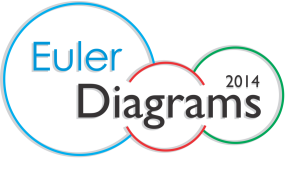Euler Diagrams 2014

The proceedings are now available.
Euler diagrams represent relationships between sets, including intersection, containment, and disjointness. These diagrams have become the foundations of various visual languages and have notably facilitated the modelling of, and logical reasoning about, complex systems. Over the years, they have been extensively used in areas such as biosciences, business, criminology and national security to intuitively visualize relationships and relative cardinalities of sets. This widespread adoption has allowed analysis of complex collections of data.
HIGHLIGHTS
- Our keynote speaker is Professor Atsushi Shimojima. More details.
- Programme.
- Proceedings will be published by CEUR.
- We will invite authors of the best papers to submit extended versions of their work to a special issue of the Journal of Logic, Language and Information.
The workshop will cover all aspects of Euler diagram research, including, but not limited to:
- Theoretical Advances: drawability, layouts, logic, reasoning,
- Software Support: diagram generation, automated reasoning, data exploration,
- Real-World Applications: system modelling, information visualization, education,
- Cognition and Perceptual Principles: readability, aesthetics and evaluation, including comparison to other representations.
Recently, there have been significant advances in all of the above areas. This workshop of peer-reviewed submissions will afford the growing Euler diagrams community the opportunity to present and discuss new research, and share multi-interdisciplinary expertise. We envisage that this will stimulate collaborations on current and future research needs. This will be the second time the workshop has run as part of the Diagrams conference series and the fourth Euler diagrams workshop (after successful workshops in 2012, 2004 and 2005). The workshop will bring together researchers with diverse backgrounds, from both academia and industry including: mathematicians, computer scientists, artificial intelligence experts, information designers, visualization experts, human-computer interaction experts and users from various application areas.
We solicit submissions on the topics mentioned above, in the following forms:
- full papers (15 pages), consisting of:
- original research
- surveys - short papers (7 pages), consisting of:
- systems descriptions
- software demonstrations
- position statements
- original research contributions
All submissions should be in LNCS format. Submit via EasyChair.
For both full and short papers:
| Paper Submission | May 12th |
| Notification | May 27th |
| Workshop | Monday July 28th 2014 |
Registration details will be made available nearer the workshop.
We are pleased to announce that Professor Atsushi Shimojima (homepage) will give the keynote talk, entitled Euler systems as feature indicator systems.
Atsushi Shimojima is Professor of Culture and Information Science at Doshisha University in Japan. He received his doctoral degree from the Philosophy Department at Indiana University in 1996. His research so far has been focused on applying semantical analysis of diagrammatic systems to make predictions on their cognitive potentials and verifying these predictions on the basis of psychological experimentation. A good example of this coupling of semantic analysis and cognitive science is found in his recent publication with Yasuhiro Katagiri in the journal, Cognitive Science, entitled An Eye-Tracking Study of Exploitations of Spatial Constraints in Diagrammatic Reasoning. His work on the semantics of diagrams is being crystalized into a book, Semantic Properties of Diagrams and Their Cognitive Potentials, to be published in 2014. He is currently interested in formalizing his theory in the framework of channel theory (Barwise & Seligman 1997) to make it more readily applicable to real-world diagrammatic systems.
The workshop will be held in the Collins Room.
13:30 – 13:40 Welcome
13:40 – 14:10 Luana Micallef and Peter Rodgers. Computing the Region Areas of Euler Diagrams Drawn with Three Ellipses.
14:10 – 14:35 Mithileysh Sathiyanarayanan and John Howse. Well-matchedness in Euler Diagrams.
14:35 – 15:00 Aidan Delaney, Eric Kow, Peter Chapman and Jon Nicholson. Generating and Navigating Large Euler Diagrams.
15:00 – 15:20 Break
15:20 – 16:20 Keynote talk by Atsushi Shimojima. Euler systems as feature indicator systems.
16:20 – 17:10 Future directions on tooling: Beryl Plimmer, Mateja Jamnik and Jim Burton.
17:10—17:15 Closing remarks.
ORGANIZERS
Jim Burton (University of Brighton, UK)
Gem Stapleton (University of Brighton, UK)
PROGRAM COMMITTEE
- Francesco Bellucci (Tallinn University of Technology)
- Peter Chapman (University of Brighton)
- Rosario de Chiara (Poste Italiane)
- Renata de Freitas (Universidade Federal Fluminense)
- Tim Dwyer (Monash University)
- Jean Flower (Autodesk)
- Mateja Jamnik (University of Cambridge)
- Luana Micallef (University of Kent)
- Mitsuhiro Okada (Keio University)
- Peter Rodgers (University of Kent)
- Frank Ruskey (University of Victoria)
- Sun-Joo Shin (Yale University)
If you have any questions, please contact the workshop organizers ed2014@easychair.org.
